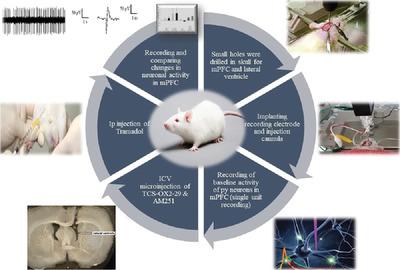Our official English website, www.x-mol.net, welcomes your feedback! (Note: you will need to create a separate account there.)
Effects of selective orexin receptor-2 and cannabinoid receptor-1 antagonists on the response of medial prefrontal cortex neurons to tramadol
SYNAPSE ( IF 2.3 ) Pub Date : 2022-03-21 , DOI: 10.1002/syn.22232 Neda Hasanpour Razmanjani 1 , Parham Reisi 1
SYNAPSE ( IF 2.3 ) Pub Date : 2022-03-21 , DOI: 10.1002/syn.22232 Neda Hasanpour Razmanjani 1 , Parham Reisi 1
Affiliation

|
Tramadol is widely used to control pain in various diseases, but the relevant mechanisms are less known despite the severe risks of abuse. The medial prefrontal cortex (mPFC) is one of the critical centers of the reward system. Studies have shown that orexins and endocannabinoids are likely to play an important role in addiction. In this study, the effect of orexin receptor-2 (OX2R) and endocannabinoid receptor-1 (CB1R) blockade on the neuronal activity of mPFC was investigated in response to tramadol in male rats. Tramadol was injected intraperitoneally, and its effects on the firing of mPFC pyramidal neurons were investigated using in vivo extracellular single-unit recording. Tramadol affected the pyramidal neuronal activity of the mPFC. AM251 (18 nmol/4 μl), as a selective CB1R antagonist, and TCS-OX2-29 (50 nmol/4 μl), as a selective OX2R antagonist, individually or simultaneously were microinjected into the lateral ventricle of the brain (intracerebroventricular, ICV). The results showed that the ratio of neurons with the excitatory/inhibitory or no responses was significantly changed by tramadol (p < .05). These changes were prevented by blockade of CB1Rs alone or blockade of OX2Rs and CB1Rs simultaneously (p < .05). However, blockade of these receptors in the vehicle group had no significant effect on neuronal activity. The findings of this study indicate the potential role of orexin and endocannabinoid systems in mediating the effects of tramadol in mPFC and the possible interaction between the two systems via OX2 and CB1 receptors. However, further studies are needed to identify these effects by examining intracellular signaling.
中文翻译:

选择性食欲素受体 2 和大麻素受体 1 拮抗剂对内侧前额叶皮层神经元对曲马多反应的影响
曲马多广泛用于控制各种疾病的疼痛,但尽管存在严重的滥用风险,但相关机制却鲜为人知。内侧前额叶皮层 (mPFC) 是奖励系统的关键中心之一。研究表明,食欲素和内源性大麻素可能在成瘾中发挥重要作用。在这项研究中,研究了食欲素受体 2 (OX2R) 和内源性大麻素受体 1 (CB1R) 阻断对 mPFC 神经元活性的影响,以响应雄性大鼠的曲马多。曲马多腹腔注射,并使用体内细胞外单单元记录研究其对 mPFC 锥体神经元放电的影响。曲马多影响 mPFC 的锥体神经元活动。AM251 (18 nmol/4 μl),作为选择性 CB1R 拮抗剂,和 TCS-OX2-29 (50 nmol/4 μl),作为选择性 OX2R 拮抗剂,单独或同时显微注射到大脑的侧脑室(脑室内,ICV)。结果表明,曲马多显着改变了兴奋/抑制或无反应的神经元比例。p < .05)。单独阻断 CB1Rs 或同时阻断 OX2Rs 和 CB1Rs 可以防止这些变化 ( p < .05)。然而,在载体组中阻断这些受体对神经元活动没有显着影响。本研究的结果表明食欲素和内源性大麻素系统在介导曲马多在 mPFC 中的作用中的潜在作用以及这两个系统之间可能通过 OX2 和 CB1 受体相互作用。然而,需要进一步的研究来通过检查细胞内信号来确定这些影响。
更新日期:2022-03-21
中文翻译:

选择性食欲素受体 2 和大麻素受体 1 拮抗剂对内侧前额叶皮层神经元对曲马多反应的影响
曲马多广泛用于控制各种疾病的疼痛,但尽管存在严重的滥用风险,但相关机制却鲜为人知。内侧前额叶皮层 (mPFC) 是奖励系统的关键中心之一。研究表明,食欲素和内源性大麻素可能在成瘾中发挥重要作用。在这项研究中,研究了食欲素受体 2 (OX2R) 和内源性大麻素受体 1 (CB1R) 阻断对 mPFC 神经元活性的影响,以响应雄性大鼠的曲马多。曲马多腹腔注射,并使用体内细胞外单单元记录研究其对 mPFC 锥体神经元放电的影响。曲马多影响 mPFC 的锥体神经元活动。AM251 (18 nmol/4 μl),作为选择性 CB1R 拮抗剂,和 TCS-OX2-29 (50 nmol/4 μl),作为选择性 OX2R 拮抗剂,单独或同时显微注射到大脑的侧脑室(脑室内,ICV)。结果表明,曲马多显着改变了兴奋/抑制或无反应的神经元比例。p < .05)。单独阻断 CB1Rs 或同时阻断 OX2Rs 和 CB1Rs 可以防止这些变化 ( p < .05)。然而,在载体组中阻断这些受体对神经元活动没有显着影响。本研究的结果表明食欲素和内源性大麻素系统在介导曲马多在 mPFC 中的作用中的潜在作用以及这两个系统之间可能通过 OX2 和 CB1 受体相互作用。然而,需要进一步的研究来通过检查细胞内信号来确定这些影响。



























 京公网安备 11010802027423号
京公网安备 11010802027423号